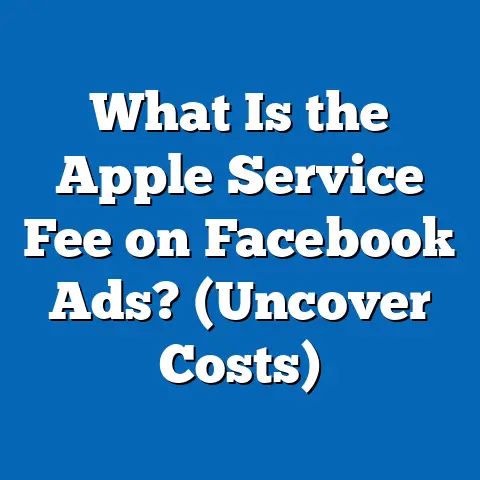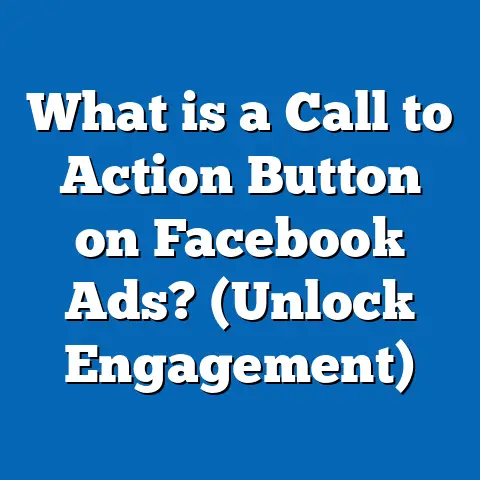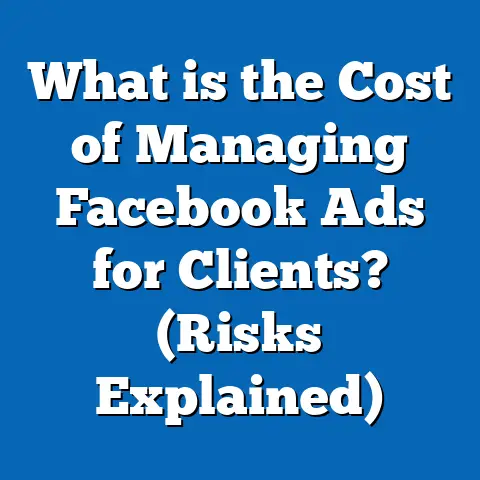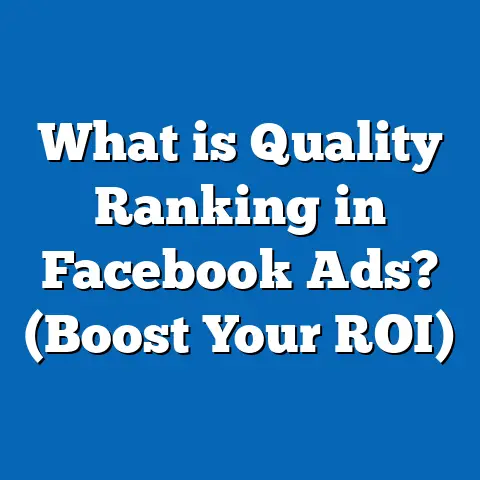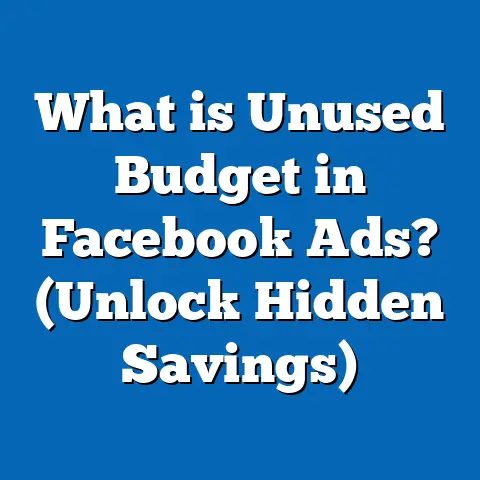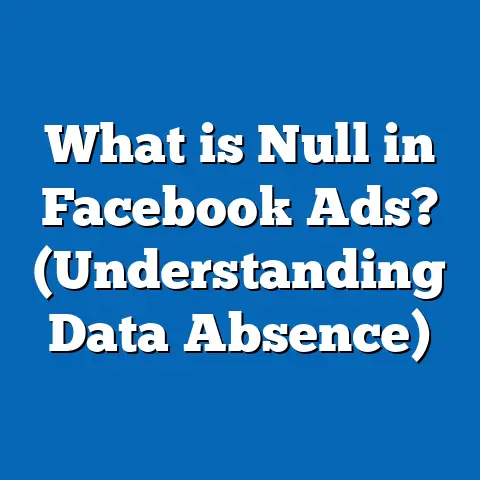What is Ad Revenue on Facebook? (Unlocking Profit Potential)
What is Ad Revenue on Facebook? (Unlocking Profit Potential)
Introduction: The Frustration of Missing Out on Facebook’s Ad Revenue
You’ve invested months or even years growing your Facebook presence—building followers, creating engaging posts, and fostering a community. Yet when it comes to monetizing that attention, the results fall short. Your ad campaigns don’t generate expected returns, or your content fails to generate meaningful income despite healthy engagement.
This frustration is common among marketers and business owners alike. Facebook’s advertising platform is one of the largest and most powerful in the world, yet many struggle to unlock its full revenue potential. Why? Because understanding what “ad revenue on Facebook” really means requires knowledge of complex systems, tools, and strategies that are constantly evolving.
This guide will demystify Facebook ad revenue—from basic concepts to advanced tactics—backed by data, case studies, and actionable insights. Whether you’re a marketing professional aiming to improve ROI or a business owner looking to diversify income streams, this comprehensive resource will help you harness Facebook’s advertising power effectively.
Understanding Facebook Ad Revenue: The Foundation
What is Facebook Ad Revenue?
At its core, Facebook ad revenue refers to the money generated from ads delivered through Facebook’s platform. This revenue flows through multiple channels:
- Advertisers pay Facebook to run ads targeted at specific users.
- Publishers and content creators earn money by hosting ads within their content or apps via programs like the Facebook Audience Network.
- Businesses earn sales or leads as a direct result of these ads.
Facebook acts as an intermediary, connecting advertisers with audiences through its vast targeting capabilities. The revenue model splits between Meta (Facebook’s parent company) and those providing valuable inventory (e.g., publishers or creators).
Types of Facebook Ad Revenue Streams
Understanding ad revenue requires recognizing different streams that contribute to income:
| Revenue Stream | Description | Who Earns It |
|---|---|---|
| Direct Ad Spend | Money advertisers pay for placing ads on Facebook | Meta |
| In-Stream Video Ads Revenue | Ads inserted into videos viewed on Facebook | Content creators & Meta |
| Audience Network Revenue | Ads shown in third-party apps or websites via Facebook’s network | Publishers & Meta |
| Sponsored Content | Paid promotions posted by brands or influencers | Influencers/Content creators |
| Facebook Shops & Commerce Ads | Ads promoting products directly linked to Facebook shops | Businesses |
Each stream has unique mechanics and earning potential.
Why Is Facebook Such a Lucrative Platform?
- Massive user base: Over 3 billion monthly active users globally (Meta Q1 2024).
- Advanced targeting: Ability to segment audiences by age, location, interests, behaviors, purchase history, and more.
- Diverse ad formats: From image ads and video ads to Stories and Messenger ads.
- Robust analytics: Tools like Facebook Ads Manager allow precise measurement.
- Integrated e-commerce features: Shops and live shopping enable direct selling.
How Facebook Makes Money: The Advertising Ecosystem
Advertisers: The Primary Revenue Source
Advertisers come from all sectors—retail, travel, finance, gaming, education—and pay Facebook to display ads targeting users most likely to engage or convert.
Facebook charges advertisers based on:
- Cost Per Click (CPC): Payment occurs when users click an ad.
- Cost Per Mille (CPM): Payment per 1000 impressions/views.
- Cost Per Action (CPA): Payment when users complete specific actions like purchases or sign-ups.
Publishers and Content Creators: Monetizing Audience Attention
Content creators can monetize their videos using in-stream ads. When a video viewer watches an ad embedded in the video, the creator earns a share of the revenue.
Publishers can also monetize their websites and apps via the Audience Network—Facebook’s program that places ads outside Facebook but uses its targeting data.
Meta’s Share of Ad Revenue
Facebook retains a portion of advertiser payments as platform fees. For example:
- In-stream video ads typically have a revenue split of about 55% to creators and 45% to Meta.
- For direct ad campaigns run by businesses, Meta keeps most of the ad spend as revenue.
Deep Dive into Key Data Points and Insights
Facebook Advertising Revenue Growth
- In 2023, Facebook’s ad revenue was approximately $150 billion, representing over 80% of Meta’s total revenue (Statista).
- Annual growth averaged around 15% year-over-year despite increasing competition from platforms like TikTok.
- Mobile ads constitute over 94% of total Facebook ad revenue due to mobile-first user behavior.
User Engagement and Ad Performance Benchmarks
- Average CTR (Click-Through Rate) across industries is about 0.9%, with sectors like retail achieving up to 1.6% (WordStream).
- Average conversion rates from Facebook ads vary but are typically between 9-12% for e-commerce campaigns with optimized funnels (HubSpot).
- Video ads show higher engagement rates; approximately 85% of users watch at least 3 seconds of video ads (Facebook IQ).
Creator Earnings Insights
- Creators using in-stream ads have reported a median CPM of around $4-$7, depending on niche and audience geography.
- Optimizing video length between 1-3 minutes can increase ad revenue by up to 30%.
- Engagement metrics such as comments and shares correlate with higher CPMs.
Breaking Down Facebook Ad Formats for Revenue Impact
Image Ads
- Best for brand awareness and simple promotions.
- Easy to create and cost-effective.
- Average CTR ~0.9%.
Video Ads
- More immersive; ideal for storytelling.
- Higher engagement rates; average view time ranges from 15 seconds up to several minutes.
- Effective for both brand building and direct response campaigns.
Carousel Ads
- Allow showcasing multiple products or features in one ad.
- Can increase CTR by up to 10% compared to single image ads.
In-stream Video Ads
- Appear during longer video content.
- Monetized directly by content creators.
Stories Ads
- Full-screen vertical format optimized for mobile.
- High engagement but shorter attention span (5–15 seconds).
Lead Ads
- Capture user information without leaving the platform.
- High conversion rates for service-based businesses.
Leveraging Facebook Analytics for Maximizing Ad Revenue
Using Facebook Pixel Effectively
The Facebook Pixel is essential for tracking user activity on your website:
- Tracks conversions like purchases, sign-ups, and add-to-cart events.
- Enables retargeting campaigns targeting previous visitors.
- Helps build custom audiences based on actions taken.
Businesses using Pixel see an average lift of 20% in conversion rates due to better targeting.
Audience Insights Tool
Provides demographic and behavioral data about your audience:
- Age, gender, location
- Interests such as hobbies and brand affinities
- Device usage patterns
Using this data helps you tailor messaging and creative for maximum relevance.
Advanced Targeting Techniques That Boost Ad Revenue
Custom Audiences
Create audiences based on:
- Website visitors tracked via Pixel
- Email lists uploaded directly
- Engagement on Facebook or Instagram pages
Custom audiences typically yield a higher conversion rate due to prior familiarity.
Lookalike Audiences
Facebook automatically finds new people similar to your best customers:
- Can target up to 10 million people in large countries.
- Often results in CTR increases of 25%-30% compared to broad targeting.
Retargeting Campaigns
Focus on users who engaged but did not convert:
- Use dynamic product ads showing items users viewed but didn’t buy.
- Retargeting ads have conversion rates up to 70% higher than cold audience campaigns.
Budgeting Strategies to Maximize Facebook Ad Revenue
Starting Small with Testing Budgets
Begin with $5-$20 per day campaigns focused on testing different creatives and audience segments. This approach minimizes risk while identifying top performers.
Scaling Winning Campaigns Gradually
Once you identify high-performing ads:
- Increase budget by 20–30% every few days rather than doubling abruptly.
- Duplicate campaigns with slight variations for A/B testing at scale.
- Monitor frequency metrics; too high frequency can cause ad fatigue and reduce ROI.
Bidding Strategies Explained
Facebook offers various bidding options:
| Bid Type | Description | Best Use Cases |
|---|---|---|
| Lowest Cost | Automatically gets best results at lowest cost | Beginners or broad targeting |
| Cost Cap | Controls max cost per conversion | Campaigns with strict CPA goals |
| Bid Cap | Sets max bid in auction | Highly competitive markets |
| Target ROAS | Optimizes for return on ad spend | E-commerce & direct sales |
Choosing the right bid strategy impacts both cost efficiency and revenue generation.
Crafting Winning Ad Creatives That Drive Revenue
Visuals Matter: Use High-quality Images and Videos
Eye-catching visuals increase attention span. Use:
- Bright colors contrasting with the background
- Text overlays highlighting key benefits
- Branding elements subtly included
Copywriting Tips for Conversion
Effective copy should:
- Address pain points clearly
- Highlight value propositions
- Include strong CTAs like “Shop Now,” “Learn More”
Testing Variations for Optimization
A/B test different:
- Headlines
- Images/videos
- CTA buttons
- Offer types (discount vs. free shipping)
Case Studies: Unlocking Real Profit Potential Through Facebook Ads
Case Study 1: Beauty Brand Triples Sales by Using Video Ads & Lookalike Audiences
A mid-sized beauty brand ran video ads targeting lookalike audiences based on previous purchasers. By optimizing video length under 30 seconds and testing different offers, they tripled monthly sales from $50K to $150K within six months.
Key outcomes:
- CTR increased from 0.8% to 1.5%
- Conversion rate improved from 10% to 18%
Case Study 2: SaaS Company Uses Retargeting To Increase Leads by 40%
A SaaS company implemented retargeting campaigns using lead ads targeted at website visitors who abandoned free trials. They increased lead generation by 40% while reducing cost per lead by 25%.
Comparing Facebook Ad Revenue with Other Digital Platforms
| Feature | YouTube | TikTok | ||
|---|---|---|---|---|
| Monthly Active Users | ~3 billion | ~2 billion | ~2 billion | ~1 billion |
| Main Ad Formats | Image, Video, Stories, Carousel | Video Pre-roll/In-stream | Image, Stories, Reels | Short video clips |
| Average CPM | $7 – $15 | $9 – $20 | $5 – $12 | $10 – $25 |
| Monetization Models | Direct ads + in-stream + shops | AdSense + memberships | Sponsored posts + stories | Creator fund + branded content |
| Strength | Advanced targeting + scale | Video monetization + search | Visual-first + influencer marketing | Viral content + youth audience |
Facebook balances scale with granular targeting unmatched by most platforms.
Impact of Privacy Changes on Facebook Ad Revenue
Apple’s iOS 14+ updates limit tracking capabilities via App Tracking Transparency (ATT). This affects:
- Data available through Pixel for retargeting
- Accuracy of attribution models
- Costs per acquisition rising due to reduced effectiveness
Marketers adapt by:
- Collecting first-party data directly via website/email lists
- Using aggregated event measurement tools
- Focusing more on brand awareness over direct response initially
Despite challenges, Facebook remains profitable due to scale.
The Future of Facebook Ad Revenue: Trends & Predictions for 2024+
- AI-Powered Campaign Optimization Machine learning tools increasingly automate bidding, creative optimization, and audience targeting leading to improved ROAS.
- Video Content Dominance Short-form videos (Reels) will become key drivers of ad revenue due to greater engagement vs static images.
- Commerce Integration Live shopping events combined with ads will create seamless purchase experiences boosting direct sales revenue.
- Privacy-first Marketing Brands will rely more on first-party data strategies and enhanced consent frameworks for sustainable growth.
- Metaverse Advertising Emerging virtual reality spaces owned by Meta may open new ad formats and revenue streams beyond traditional social media channels.
Step-by-Step Guide: How To Start Generating Ad Revenue on Facebook Now
- Set Clear Goals Define whether you want sales, leads, brand awareness, or content monetization.
- Install Facebook Pixel Place Pixel code on your website for tracking conversions accurately.
- Identify Target Audiences Use Audience Insights & your customer data to create custom and lookalike audiences.
- Choose Appropriate Ad Formats Match format choice with your goals—video for storytelling; lead ads for list building.
- Create Compelling Creatives Use high-quality visuals and clear messaging with strong CTAs.
- Launch Test Campaigns Start with small budgets ($5-$20/day) testing different creative/audience combos.
- Analyze Results Monitor CTR, CPC, conversion rate, ROAS regularly in Ads Manager.
- Optimize & Scale Pause underperforming ads; increase budget gradually on winners.
- Explore Monetization Programs If you’re a content creator, apply for in-stream ads or join Audience Network.
- Stay Updated Follow industry news on privacy changes & new features regularly.
FAQs About Facebook Ad Revenue
Q1: Can individuals make significant income from Facebook ad revenue?
Yes—especially creators who monetize videos through in-stream ads or influencers running sponsored content can earn substantial amounts depending on audience size and engagement.
Q2: How long does it take to see results from Facebook advertising?
Typically within 1–2 weeks of running campaigns with sufficient budget you can start seeing meaningful data to optimize.
Q3: Are there industries that perform better on Facebook?
Retail, e-commerce, fitness, entertainment, and education tend to see higher engagement and ROI due to highly visual products/services.
Summary & Final Takeaways
Facebook ad revenue represents a powerful opportunity for businesses and creators worldwide but requires strategic understanding and continual optimization. Key points include:
- Master audience targeting using Pixel, custom audiences, and lookalike audiences.
- Choose ad formats aligned with campaign goals—video ads tend to drive higher engagement.
- Optimize creatives rigorously through A/B testing.
- Start small with budgets; scale based on data-driven performance analysis.
- Adapt quickly to privacy changes by leveraging first-party data strategies.
- Monitor key metrics such as CTR, conversion rate, and ROAS closely.
By applying these principles consistently while staying updated with platform changes, marketers can unlock significant profit potential from Facebook’s vast advertising ecosystem.
If you want me to provide templates for campaign setups or detailed checklists for each step mentioned above, I can prepare those as well. Would you like that?

